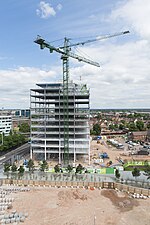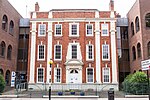Coventry ring road

The A4053 Coventry ring road is a 2.25-mile (3.62 km) ring road in Coventry, England, which forms a complete dual-carriageway loop around the city centre. The road encompasses the old and new Coventry Cathedrals, the city's shopping areas and much of Coventry University. With the exception of one roundabout at junction 1, the ring road's nine junctions are entirely grade separated and closely spaced, with weaving sections between them, some as short as 300 yards (270 m), giving the road a reputation for being difficult to navigate. The junctions include connections with three other A roads: the A4114, A4600 and A429. From the 1930s, Coventry City Council began replacing the city's narrow medieval streets with modern roads, to cope with a rapidly growing population. City architect Donald Gibson began work in 1939 on a city centre redevelopment plan which expanded in scope following World War II, in which large areas of the city were destroyed by German bombs. The shopping area was rebuilt first, followed by the ring road, which was constructed in six stages from 1959. Early stages were built with at-grade junctions, cycle tracks and footpaths, envisaged as a surface-level linear park. Following traffic surveys in the early 1960s, however, the council amended the design to include grade separation and the weaving sections. Research by the city engineer indicated that it was the first urban road in the world to use this configuration at such a small scale. The road was completed in 1974, with an overall cost of £14.5 million (equivalent to £160,800,000 in 2021). As one of the few British cities to see its ring road project pushed to completion, Coventry has received considerable attention as a source of research for post-war architecture. An article by BBC News noted that opinions about the road were varied, concluding that "you either love it or you hate it". The road was the subject of a 2015 series of poetry films and driving on it has been likened to driving a Scalextric car and riding on a roller coaster.
Excerpt from the Wikipedia article Coventry ring road (License: CC BY-SA 3.0, Authors, Images).Coventry ring road
Ringway St Patricks, Coventry Cheylesmore
Geographical coordinates (GPS) Address Nearby Places Show on map
Geographical coordinates (GPS)
| Latitude | Longitude |
|---|---|
| N 52.4031 ° | E -1.51019 ° |
Address
Ringway St Patricks
Ringway St Patricks
CV1 2LP Coventry, Cheylesmore
England, United Kingdom
Open on Google Maps










